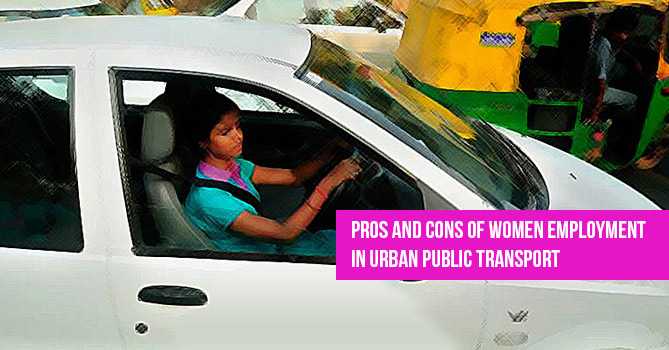In recent years, it has been found that women are coming forward to work in urban public transport, a sector which was earlier considered as a purely male dominated sector. With increasing rapes, molestation and eve teasing, it is better to have more women drivers. After the infamous incident of an Uber taxi driver raping a female passenger or the Nirbhaya gang rape case, there is more need for female drivers in India. More and more women are travelling late-nights because of night shifts or late working hours or just staying out with friends and male-driven cabs and other public transports have proved to be unsafe, especially for women who are travelling solo. Taking safety factor of women in mind and also to provide job opportunities to women, some NGOs and transport service providers are opening up avenues for providing training and employment to women drivers in urban public transport.
Brands like SheCabs, Priyadarshini Taxi Service, GCabs, Viira Cabs and Sakha Cab Company have started employing more women to meet the demand of women travelers in Indian cities. Prominent among these is the Sakha cab company, launched in 2008 by Azad Foundation, a Delhi-based NGO. A branch of Sakha Consulting Wings, the company launched its car-hire and chauffeur service with women drivers. In Sakha cabs, men cannot ride unless a female passenger is also present. This was New Delhi’s first such cab service. Sakha runs a 24-hour service and cabs need to be booked at least four hours ahead of time. The company has also opened branches in Jaipur, Indore and Kolkata.
Problems
The concept of hiring female drivers is still not popular in India, as a result of which many of these cab companies have not been able to make an impact in this male-dominated sector.
- No investors: Unlike popular radio taxi companies like Easy Cabs, Ola and Meru Cabs that are rich enough to buy hundreds of cars at a time, women-centred taxi services have less capital for investment and they operate more like non-profits or social enterprises rather than business ventures. As a result of lack of capital and profits, several women-centred taxi companies have disappeared or have reduced their numbers.
- More expensive: Women-driven taxis are costlier as compared to regular taxi services. For instance, Priyadarshini in Mumbai charges Rs. 250 for the first 10 km and after that Rs. 21 per km. On the other hand, Ola charges only Rs. 15 per km. As such, very few women passengers can afford to hire their services.
- Less faith: Also most people have less confidence in women drivers. As a result, they hesitate to call a woman taxi driver.
- Restricted to female passengers only: The general opinion is that the cabs driven by women drivers are meant for female passengers only, which is actually not the case. The number of female passengers is comparatively lesser than males. This is another factor for such businesses not being successful in India.
The positive impact
- Almost all the female recruits in these cab companies are from poor families. This is one of the positive impacts as more and more poor women are being able to earn for their families.
- The service is all the more helpful for single mothers or widows or uneducated girls who can earn and stand on their own feet.
- These women are not only given training to drive but are provided guidance on their rights and safety.
- Women cab drivers have become financially independent and their confidence and self-esteem have gone high. They are empowered to make their own decisions.
- By working as cab drivers, many women have also been able to continue with their studies as they can now afford to pay their fees and buy their books.
- Some women were able to invest in property to secure their future.
Metro cities like Delhi, Bangalore and Mumbai are a promising market for cabs driven by women. Slowly it is improving. Employing women in the driving business is indeed a good idea for women empowerment as it will increase the employment factor but as far as safety of women is considered, it is very difficult to say whether it will be reduced or not. But there is no doubt that such service has been started in India only “For Safety, Security and Dignity of Women”.
